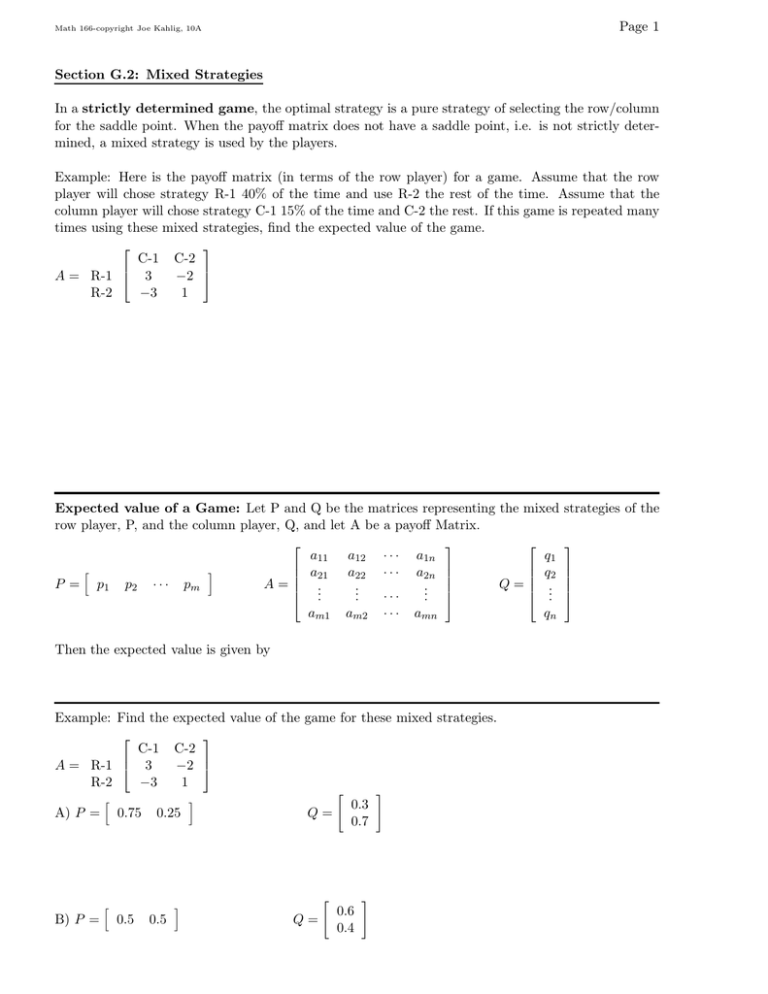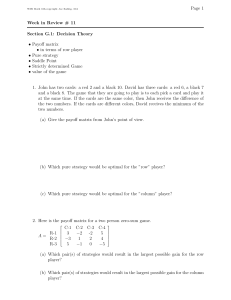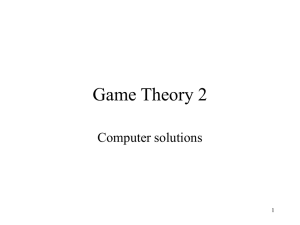Page 1 Section G.2: Mixed Strategies
advertisement

Page 1 Math 166-copyright Joe Kahlig, 10A Section G.2: Mixed Strategies In a strictly determined game, the optimal strategy is a pure strategy of selecting the row/column for the saddle point. When the payoff matrix does not have a saddle point, i.e. is not strictly determined, a mixed strategy is used by the players. Example: Here is the payoff matrix (in terms of the row player) for a game. Assume that the row player will chose strategy R-1 40% of the time and use R-2 the rest of the time. Assume that the column player will chose strategy C-1 15% of the time and C-2 the rest. If this game is repeated many times using these mixed strategies, find the expected value of the game. C-1 A = R-1 3 R-2 −3 C-2 −2 1 Expected value of a Game: Let P and Q be the matrices representing the mixed strategies of the row player, P, and the column player, Q, and let A be a payoff Matrix. P = h p1 p2 pm ··· i A= a11 a21 .. . a12 a22 .. . am1 am2 ··· ··· ··· ··· a1n a2n .. . amn Then the expected value is given by Example: Find the expected value of the game for these mixed strategies. C-1 A = R-1 3 R-2 −3 A) P = h B) P = h 0.75 0.5 C-2 −2 1 0.25 0.5 i i Q= Q= " " 0.3 0.7 0.6 0.4 # # Q= q1 q2 .. . qn Page 2 Math 166-copyright Joe Kahlig, 10A Definition: For every choice of strategy for the row player there is a best counterstrategy–that is a strategy for the column player that results in the least expected value for the game. An optimal mixed strategy for the row player is one for which the expected value against the column player’s best counterstrategy is as large as possible. Definition: For every choice of strategy for the column player there is a best counterstrategy–that is a strategy for the row player that results in the largest expected value for the game. An optimal mixed strategy for the column player is one for which the expected value against the column player’s best counterstrategy is as small as possible. Theorem: For a game with the payoff matrix given as A= " a c b d # Then the optimal mixed strategy for the row player is given by P = h p1 p2 i , where p1 = d−c and p2 = 1 − p1 . a+d−b−c The optimal mixed strategy for the column player is given by Q= " q1 q2 # , where q1 = d−b and q2 = 1 − q1 . a+d−b−c The value of the game(expected value) is E = P AQ = ad − bc a+d−b−c Example: Find the value of the game and the optimal strategy for the row and column players. A= " 3 2 −1 4 # Example: Find the value of the game and the optimal strategy for the row and column players. A= " 15 −5 10 20 # Page 3 Math 166-copyright Joe Kahlig, 10A Example: Which of these strategies should never be used by the row player? A= R-1 R-2 R-3 C-1 4 6 5 C-2 5 7 6 C-3 2 3 8 Example: Which of these strategies should never be used by the column player? A= R-1 R-2 R-3 C-1 4 6 5 C-2 5 7 6 C-3 2 3 8 Definition: Row i is said to dominate row j if every entry of row i is sponding entry of row j Column i is said to dominate column j if every entry of column i is ing entry of column j to the corre- to the correspond- Rows/columns that are dominated may be removed from the payoff matrix without affecting the analysis. Example: Find the optimal strategy for the row and the column player. A= R-1 R-2 R-3 C-1 4 6 5 C-2 5 7 6 C-3 2 3 8 Math 166-copyright Joe Kahlig, 10A Page 4 Example: Reduce the matrix by deleting rows or columns that are dominated by other rows or columns. 6 2 7 −3 6 4 2 1 A) B) 2 0 2 −8 2 1 4 3 −2 9 6 6 3 4 1 3 1 2 8 1 Example: Find the optional strategy for both players. 4 5 −3 4 0 2 1 2 −8 3 −2 7 −3 2 0 3






